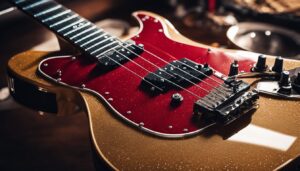As an Amazon Associate I earn from qualifying purchases.
Choosing the right electric guitar can be a daunting task for many, given the wide array of options available. Did you know that the material and shape of a guitar significantly influence its sound and playability? This article serves as your comprehensive guide to choosing an electric guitar that matches your style, skill level, and budget.
Let’s dive in and find out how you can turn this seemingly challenging task into an enjoyable experience!
Table of Contents
Factors to Consider When Choosing The Right
Electric Guitar
When choosing an electric guitar, it is important to consider factors such as size and weight, pickups, tremolo, style, and budget.
Size and Weight
The size and weight of an electric guitar significantly influence its playability and comfort during performances. Bigger, heavy guitars may offer a richer, fuller sound but can be taxing on the player’s shoulders over time.
On the other hand, smaller models are easier to handle and carry around, especially for younger or petite players. The choice of size should also align with your style; if you’re into energetic stage performance requiring constant movement, a lighter instrument would serve better.
Therefore, it is crucial to physically try several guitars before deciding on one that feels perfect in your hands and doesn’t cause discomfort even after prolonged usage.
Pickups
Singlecoil pickups are a popular choice for electric guitar players looking for clean, crisp tones. These pickups have a bright and twangy sound that is well-suited to genres like country, blues, and indie rock.
They excel at capturing the nuances of your playing, whether it’s subtle fingerpicking or aggressive strumming. If you’re into bending notes, hammer-ons, and pull-offs, singlecoil pickups will give you the clean articulations you need.
The width and depth of the neck can also affect how comfortable the guitar feels in your hands, so consider your hand size when choosing an instrument with singlecoil pickups.
Another option to consider is a solid body instrument with humbucking pickups. These pickups offer a higher output and produce a warmer, thicker tone compared to singlecoils. They are great for players who prefer hard rock or heavy metal styles where distortion is essential.
Humbuckers are less prone to picking up unwanted noise (such as humming) compared to singlecoils because they cancel out some of this interference.
Tremolo
The tremolo is a feature on an electric guitar that allows you to create a wavering effect in the pitch of your notes. It adds a unique and dynamic element to your playing, allowing you to express yourself in different ways.
Whether you’re looking to add subtle vibrato or go for more dramatic dive bombs, the tremolo can help you achieve those effects. Experimenting with different tremolo techniques can greatly enhance your playing and give your music a distinctive sound.
Style
Consider your personal style when choosing an electric guitar. Think about the genre of music you want to play and the artists who inspire you. Different styles of guitars are better suited for certain genres, so it’s important to find a guitar that matches your preferred playing style.
For example, if you’re into rock or metal, you might lean towards a solid body instrument with humbucker pickups for heavier tones. On the other hand, if you prefer clean sounds and intricate fingerpicking, a guitar with single-coil pickups and a playable neck would be more suitable.
Ultimately, finding a guitar that feels good in your hands and sounds good to your ears is key to selecting the perfect electric guitar for your style.
Budget
Consider your budget when choosing an electric guitar. Determine how much you are willing to spend and look for options that fit within your price range. Keep in mind that higher-priced guitars often offer better quality craftsmanship, components, and materials, but there are also affordable options available for beginners.
Shop around and compare prices to find the best value for your money. Don’t forget to factor in any additional costs such as accessories or amplifiers that may be necessary. Ultimately, choose a guitar that not only fits your budget but also meets your needs in terms of sound quality and playability.
Understanding the Anatomy of an Electric Guitar
This section will break down the different components of an electric guitar, including the parts, tonewoods, neck types, and fretboard woods.
Parts of an Electric Guitar
An electric guitar is made up of several key components. The body is where the strings are attached and can come in various shapes, such as solid or semi-hollow. The neck connects to the body and is where you’ll find the fretboard, which holds the frets that allow you to change notes.
At the headstock, you’ll find tuning pegs that adjust the tension of each string. Additionally, there are pickups on the body that capture the vibrations from the strings and convert them into an electrical signal that can be amplified.
Finally, there are volume and tone knobs that control the overall sound of your guitar. Understanding these different parts will help you make informed choices when selecting an electric guitar that suits your needs.
Tonewoods and Their Sonic Signatures
Different tonewoods used in electric guitars can have a significant impact on the instrument’s sonic characteristics. For example, maple is known for its bright and snappy tone, while mahogany produces warm and rich tones.
Alder offers a balanced sound with good sustain, while ash provides pronounced clarity and strong attack. Each tonewood has its own unique sonic signature, so it’s important to consider your preferred style of music when choosing an electric guitar.
By selecting a guitar with the right tonewood, you can ensure that it produces the desired sound that matches your musical preferences and playing style.
Different Types of Necks
Electric guitars come with different types of necks, each offering a unique feel and playability. One common type is the bolt-on neck, which is attached to the guitar body using screws.
This type allows for easy adjustment and replacement if needed. Another option is the set neck, where the neck is glued to the body for increased sustain and resonance. For those seeking even more sustain and stability, there are guitars with neck-through construction, where the neck extends through the entire length of the instrument.
The choice of neck largely depends on personal preference and playing style, so it’s important to try out different options to find what feels comfortable in your hands as you create clean articulations or bend notes effortlessly.
Fretboard Woods
Different types of wood are used to make the fretboards on electric guitars. The choice of wood can have a significant impact on the guitar’s tone and playability. For example, maple fretboards are known for their bright, snappy sound and smooth feel.
Rosewood fretboards, on the other hand, produce warmer tones with a rich resonance. Ebony fretboards offer a balanced and versatile sound that is favored by many professional guitarists.
Other popular choices include pau ferro, which produces a warm tone similar to rosewood, and mahogany, which adds warmth and depth to the overall sound of the guitar. Ultimately, choosing the right fretboard wood is a matter of personal preference and should be based on your desired tone and playing style.
The type of wood used for the fretboard can greatly affect how easy or difficult it is to play certain techniques such as bending notes or performing hammer-ons and pull-offs. Factors such as the width and depth of the neck also come into play when considering comfort during long playing sessions.
Key Considerations in Choosing an Electric Guitar
Consider the body style, tonewood selection, neck construction, number of frets, and pickups/electronics when choosing an electric guitar that suits your playing style.
Body Style
The body style of an electric guitar is an important factor to consider when choosing the right instrument for you. The body style determines how the guitar feels and plays, as well as its overall sound.
There are several common body styles to choose from, including solid body, semi-hollow, and hollow body guitars. Each type has its own unique characteristics that can influence your playing experience.
So, take some time to try out different body styles and see which one feels comfortable in your hands and produces the sound you’re looking for.
Tonewood Selection
The choice of tonewood will have a significant impact on the sound and tone of your electric guitar. Different types of tonewoods produce different sonic signatures, so it’s important to consider this when choosing your instrument.
Some common tonewoods include maple, mahogany, ash, alder, and rosewood. Maple is known for its bright and articulate sound, while mahogany offers warmth and depth. Ash provides a balanced tone with good sustain, alder delivers a versatile sound suitable for various genres, and rosewood adds richness to the overall tone.
Consider the type of music you want to play and the overall sound you prefer when selecting your ideal tonewood for the perfect electric guitar experience.
Neck Construction
The neck construction of an electric guitar is a crucial factor to consider when making your choice. The type of neck can greatly affect how comfortable the guitar feels in your hands and how easy it is to play.
There are different types of neck constructions, including bolt-on, set-in, and neck-through. Bolt-on necks are popular for their ease of repair and affordability. Set-in necks provide better sustain and access to higher frets.
Neck-through designs offer excellent sustain and stability. When selecting an electric guitar, take into account the width, depth, shape, and material of the neck as these factors will determine how well it fits your hand size and playing style.
In addition to considering the construction of the neck itself, think about other features that can enhance playability such as a smooth fretboard with properly dressed fret ends and low action.
Number of Frets
The number of frets on an electric guitar is an important consideration when choosing the right instrument for you. Most guitars typically have between 21 and 24 frets, although some models may have more or less.
The number of frets determines the range of notes you can play on each string, allowing you to access higher pitches as you move up the neck. A guitar with more frets provides greater versatility and allows for more complex playing techniques such as bends, hammer-ons, and pull-offs.
However, keep in mind that a larger number of frets may also result in a wider and potentially less comfortable neck to navigate. Consider your playing style and musical preferences to determine how many frets will best suit your needs.
Pickups and Electronics
The pickups and electronics of an electric guitar play a crucial role in shaping the sound you’ll produce. Pickups are essentially magnets that convert string vibrations into electrical signals, which are then sent to an amplifier.
There are two main types of pickups: single-coil and humbucker. Single-coil pickups tend to have a bright, clean sound, while humbuckers offer a thicker and more powerful tone with less noise interference.
It’s important to consider the type of music you’ll be playing and the desired sound when choosing your pickups. Additionally, pay attention to the electronic components like volume and tone controls, as they can affect the overall versatility and tweakability of your instrument’s sound.
Conclusion
In conclusion, choosing the right electric guitar for you involves considering factors like size and weight, pickups, tremolo, style, and budget. Understanding the anatomy of an electric guitar can also help with your decision-making process.
Key considerations include body style, tonewood selection, neck construction, number of frets, and pickups and electronics. By keeping these factors in mind and trying out different guitars to see how they feel and sound to you personally, you can find the perfect electric guitar that suits your needs and playing style.
FAQs
1. What factors should I consider when choosing an electric guitar?
When choosing an electric guitar, you should consider factors such as your playing style, budget, body shape and size, and the type of music you want to play.
2. How do I determine the right size electric guitar for me?
To determine the right size electric guitar for you, hold different guitars in your hands and see which one feels comfortable and natural to play. Consider factors like the neck width and length to find a guitar that suits your physicality.
3. Should I choose a solid-body or semi-hollow body electric guitar?
The choice between a solid-body or semi-hollow body electric guitar depends on your preferred tone and playing style. Solid-body guitars are versatile with a wide range of tones while semi-hollow body guitars have a warmer sound with more feedback control.
4. Do I need any additional equipment when buying an electric guitar?
Aside from the electric guitar itself, you will also need an amplifier, cables, picks (plectrums), straps, and possibly effects pedals depending on the sound you want to achieve.
Amazon and the Amazon logo are trademarks of Amazon.com, Inc, or its affiliates.





